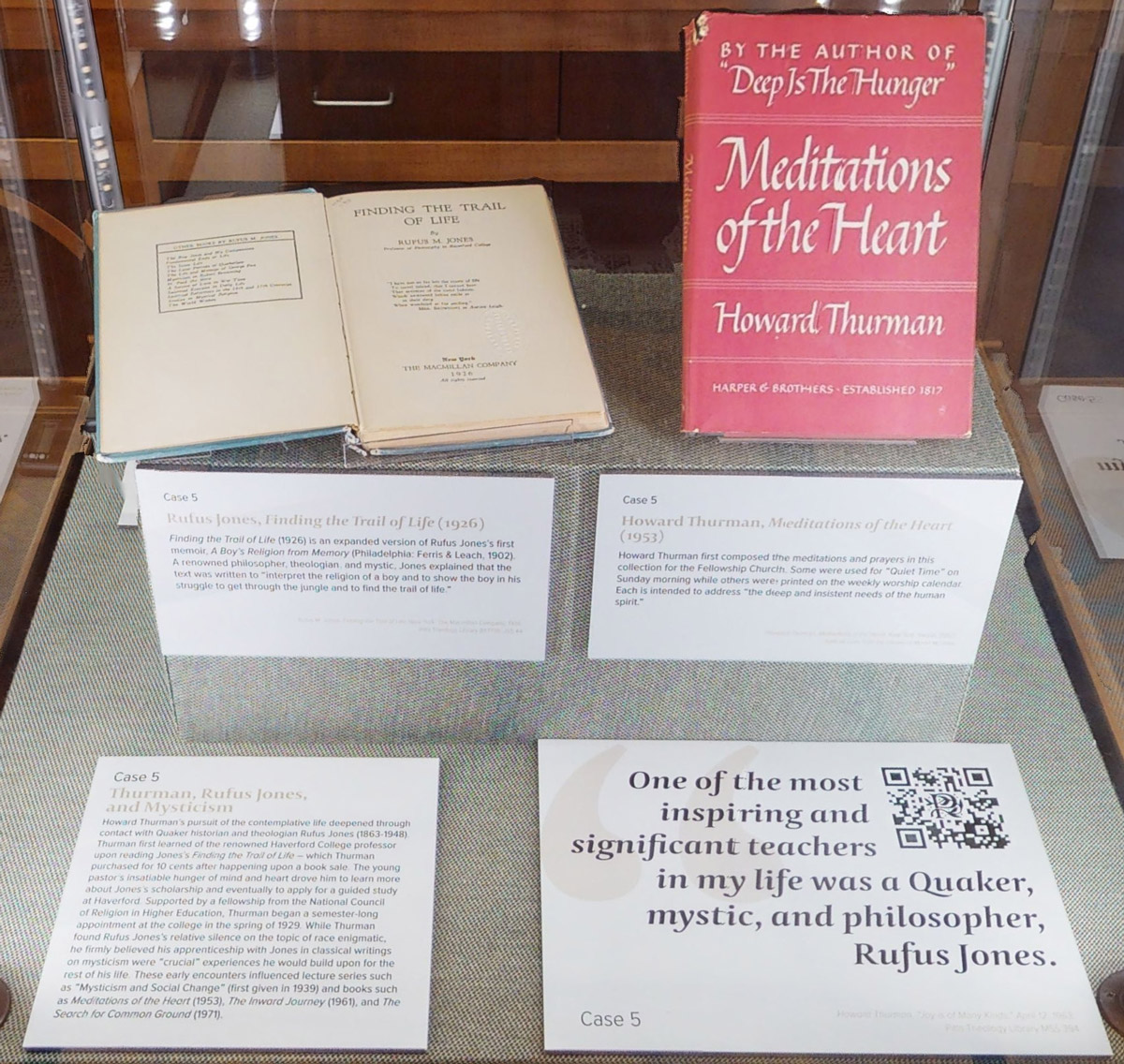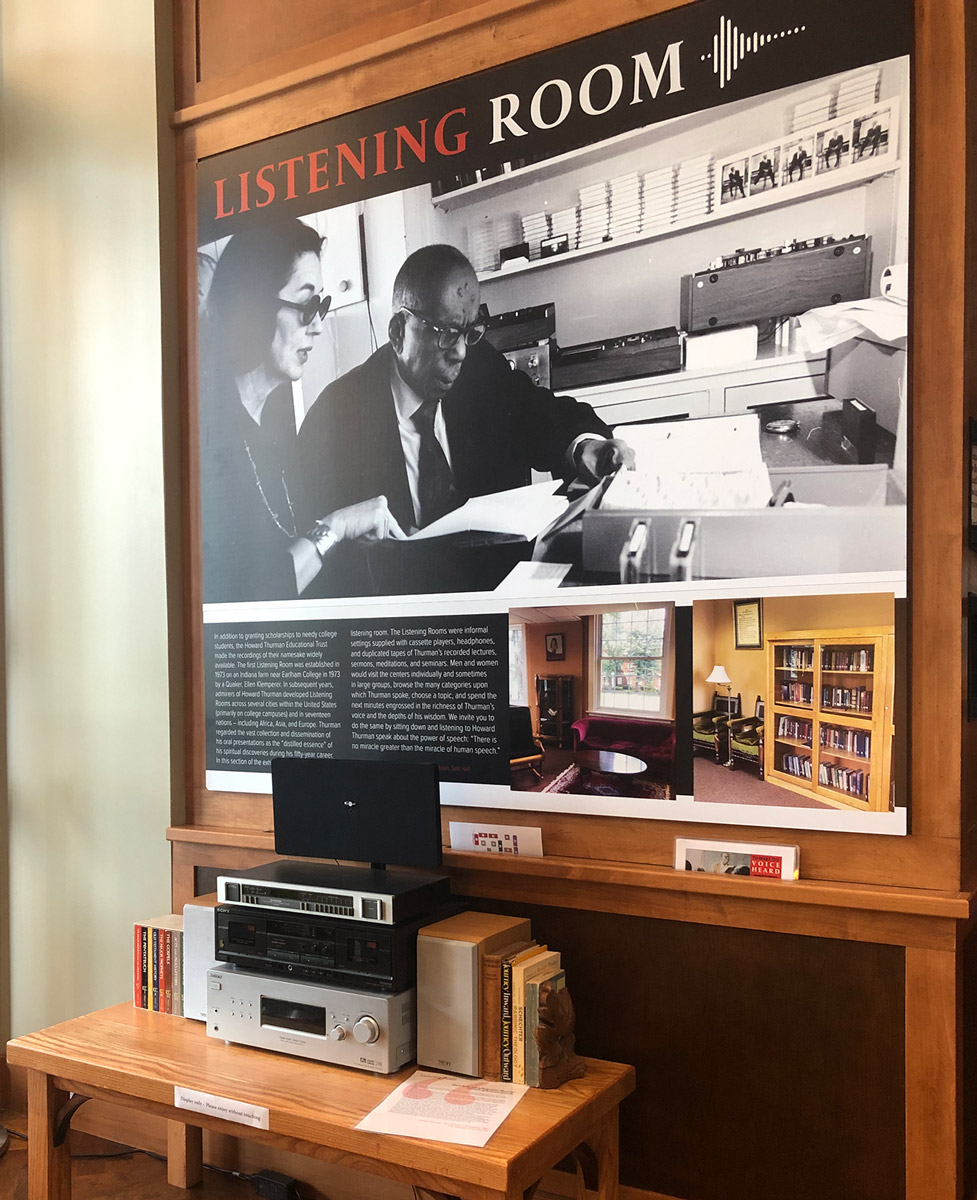Special Forum: Multimodality and Theological Librarians
To Make the Voice Heard
A Multimodal Exhibition at Pitts Theology Library
In the spring of 2022, Pitts Theology Library installed a multimodal exhibition on the lives and legacies of Howard and Sue Bailey Thurman that encouraged visitors to explore a collection of print materials, images, artifacts, and digital audio. Curated by Dr. Timothy M. Rainey II and Dr. Spencer W. Roberts, To Make the Voice Heard: Howard Thurman’s Prophetic Mysticism and Recordings During the Long Sixties adopted a unique approach that would bring the voice of Howard Thurman back to the forefront of visitors’ experience with his work. This article describes our inspiration for the content of the exhibition and our incorporation of new technologies in our gallery to create an interactive and engaging experience for our visitors.
The Listening Ear
Howard Thurman (1899-1981) was a theologian, preacher, educator, author, and civil rights leader. Today, most students and the public are primarily introduced to Thurman through his written word, particularly his best-selling Jesus and the Disinherited. Although Thurman published 21 books between 1944 and 1979, he was primarily known during his lifetime for his spoken word through lectures, sermons, and radio shows. With the advent of audio recording capabilities, venues and individuals began to capture Thurman’s spoken word on reel-to-reel and cassette tapes. The resulting collection totals over 41,000 minutes of recorded audio from the 1950s through the 1980s.
Sound and speech featured prominently in Thurman’s life and lessons in philosophy and spiritualism. As the first Dean of Rankin Chapel at Howard University in the 1930s, he added music, poetry, art, liturgical dance, and music into the services. He produced television broadcasts such as “Sing Your Own Song” that focused on the importance of hearing “the sound of one’s own heart and spirit.” Themes such as the “sound of the genuine” appear throughout his work (Neeld 2016).
In a 1960 sermon, Thurman expressed most clearly his perspective on the importance of sound and speech:
There is no miracle greater than the miracle of human speech. Think of it. Out of all the various sounds that one hears in the world, certain sounds have been limited, proscribed, given a certain shape and form, in order to convey meaning. Something that is invisible, something that is soundless, so that when a certain sound meets the ear, this sound conveys to the mind the intent of the person who uses the sound, who makes the noise (Thurman 1960).
Thurman’s emphasis on listening, speaking, sound, and silence also influenced his later seminars and the activities of his followers throughout the world. In 1961, the founding of the Howard Thurman Educational Trust led to “the dissemination of tapes, of books, of ideas that represent a lifetime of [Thurman’s] own thought and reflection and experience as a man who has undertaken to live his life on the basis of a very profound religious commitment. These tapes are in process of being made available for listening rooms, for campuses, churches, and so forth” (Thurman 1975). Over 100 of these unique listening rooms were active at different times and places in the U.S. and internationally.
These listening rooms and cassette tapes became an important point of contact between Thurman and his listeners. The Rev. Dr. Jon R. Black writes, “I survived my seminary years by spending hours in the Howard Thurman Listening Room at Garrett-Evangelical Theological Seminary” (Black 2018). In the 1970s and 80s, seminars held at the Thurmans’ office and home in San Francisco regularly involved groups listening to recordings together, participants checking out cassette tapes for their personal use in the evenings, and then group discussion of their reflections and thoughts. What a fascinating experience it is to hear Howard Thurman listening to his own words and then commenting on them.
A Modern Listening Room
In 2009, the Thurman family donated to Pitts Theology Library a collection of cassette tapes, reel-to-reel audio tapes, and film reels formerly held by the Educational Trust. Since then, the entire collection has been digitized, and many of the audio recordings have been transcribed by an automatic text recognition company called 3PlayMedia. Our project team of undergraduate and graduate students creates metadata for each recording, provides detailed descriptions, and connects themes across the collection. As recordings are processed, they are made available online through the Howard Thurman Digital Archive.
As interest in the audio collection grew, we decided to make it the focus of an exhibition in our gallery that would coincide with a Thurman-focused conference held at Candler School of Theology in April 2022. Our goal was to demonstrate the breadth of influence and legacy of both Howard and Sue Bailey Thurman, to highlight the audio collection held at Pitts, and to reproduce the experience of listening to the Thurmans in their own voices.
This raised an important question: how would we present digital audio alongside artifacts, books, images, and papers? Our gallery has a built-in speaker system that has typically been used to play quiet background music, which is not well-suited to our goal of true listening and reflecting. We recognized the need to find different solutions.
The recent resurgence of QR codes in daily life and the accompanying improvements in the technology to use them provided a simple solution. Each display case in the gallery features images, books, artifacts, or papers along with a printed card with a brief quotation, a QR code, and a citation. Visitors simply scan the QR code to play the audio clip on their mobile device, using their own headphones or borrowing a set from our rack at the gallery entrance. Eighteen different audio clips associated with case contents provide visitors with an opportunity to hear Thurman discussing related themes and topics.

Image 1: Case 5: Thurman, Rufus Jones, and Mysticism
Another innovative element of the exhibition was a section that replicated the feeling—if not the true nature—of hearing Thurman on cassette tape in the intimate environment of a listening room. At the entrance of the gallery, visitors sat in a comfortable chair next to a table and lamp, facing a stereo, speakers, and books from decades ago. As they sat, a motion-activated directional audio speaker sensed their movement and began playing a 4-minute excerpt of Thurman’s sermon on the miracle of human speech.

Image 2: The Howard Thurman Listening Room Experience at Pitts Theology Library
Our version of a listening room invited visitors to begin with a moment of quiet listening and reflection in a comfortable space, preparing for the rest of the exhibition in which the Thurmans’ voices were prominently featured. It was important for us to begin the exhibition this way because Thurman himself acknowledged, “my craft remains the spoken word” (Thurman 1979).
The Promise of Multimodal Exhibitions
In April 2022, our exhibition was visited by many attendees of The Unfinished Search for Common Ground: A Conference on the Life and Work of Howard Thurman, including members of his family, friends, mentees, and scholars of his work. Most visitors had read the books in our display cases; others had written some of them. Some guests had listened to the audio recordings before; others could be heard in them as participants in seminars with Thurman. For all these visitors, however, our exhibition was the first time that these artifacts, books, papers, and images had been brought together alongside the voices of Howard and Sue Bailey Thurman.
Anecdotally, visitors to the exhibition have enjoyed the ability to listen to the Thurmans while exploring the displays. In our guestbook, two comments suggest that our experiment with a multimodal exhibition has been successful. One visitor wrote, “Three hours well spent! I listened to every recording and read every word. My heart, mind, & soul are fed.” We imagine that the Thurmans would be glad to hear this comment. Our most glowing praise came from Dr. Luther E. Smith, Jr., a close friend and mentee of Howard Thurman, who wrote, “A wonderful exhibit that sets a standard of excellence for portraying the Thurmans’ legacy.”
To Make the Voice Heard: Howard Thurman’s Prophetic Mysticism and Recordings During the Long Sixties was open from April to July 2022. The work put into the exhibition will remain accessible through our virtual tour of the space, along with the text and audio content for each case.
Works Cited
Black, Rev. Dr. Jon R. “Even When There’s No Pressure, We Can Choose to Blossom.” Bluffton Sun (blog), April 17, 2018. https://www.blufftonsun.com/even-when-theres-no-pressure-we-can-choose-to-blossom/.
Neeld, Elizabeth Harper. “Notes On A (Brief) Introduction to the Work of Dr. Howard Thurman.” Elizabeth Harper Neeld (blog), September 21, 2016. https://elizabethharperneeld.com/2016/09/21/notes-on-a-brief-introduction-to-the-work-of-dr-howard-thurman/.
Thurman, Howard. Sing Your Own Song. We Believe (Television Series, 1958-1965). Boston, 1964. Pitts Theology Library. https://thurman.pitts.emory.edu/items/show/1259.
———. Thou Knowest It Altogether, 1960. Pitts Theology Library. https://thurman.pitts.emory.edu/items/show/211.
———. Thurman on the Howard Thurman Educational Trust, 1975. Pitts Theology Library. https://thurman.pitts.emory.edu/items/show/190.
———. With Head and Heart: The Autobiography of Howard Thurman. San Diego, CA: Harcourt Brace & Company, 1979.